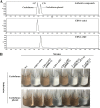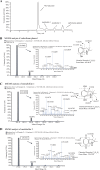Hydrolase CehA and Monooxygenase CfdC Are Responsible for Carbofuran Degradation in Sphingomonas sp. Strain CDS-1
- PMID: 29884759
- PMCID: PMC6070753
- DOI: 10.1128/AEM.00805-18
Hydrolase CehA and Monooxygenase CfdC Are Responsible for Carbofuran Degradation in Sphingomonas sp. Strain CDS-1
Abstract
Carbofuran, a broad-spectrum systemic insecticide, has been extensively used for approximately 50 years. Diverse carbofuran-degrading bacteria have been described, among which sphingomonads have exhibited an extraordinary ability to catabolize carbofuran; other bacteria can only convert carbofuran to carbofuran phenol, while all carbofuran-degrading sphingomonads can degrade both carbofuran and carbofuran phenol. However, the genetic basis of carbofuran catabolism in sphingomonads has not been well elucidated. In this work, we sequenced the draft genome of Sphingomonas sp. strain CDS-1 that can transform both carbofuran and carbofuran phenol but fails to grow on them. On the basis of the hypothesis that the genes involved in carbofuran catabolism are highly conserved among carbofuran-degrading sphingomonads, two such genes, cehACDS-1 and cfdCCDS-1, were predicted from the 84 open reading frames (ORFs) that share ≥95% nucleic acid similarities between strain CDS-1 and another sphingomonad Novosphingobium sp. strain KN65.2 that is able to mineralize the benzene ring of carbofuran. The results of the gene knockout, genetic complementation, heterologous expression, and enzymatic experiments reveal that cehACDS-1 and cfdCCDS-1 are responsible for the conversion of carbofuran and carbofuran phenol, respectively, in strain CDS-1. CehACDS-1 hydrolyzes carbofuran to carbofuran phenol. CfdCCDS-1, a reduced flavin mononucleotide (FMNH2)- or reduced flavin adenine dinucleotide (FADH2)-dependent monooxygenase, hydroxylates carbofuran phenol at the benzene ring in the presence of NADH, FMN/FAD, and the reductase CfdX. It is worth noting that we found that carbaryl hydrolase CehAAC100, which was previously demonstrated to have no activity toward carbofuran, can actually convert carbofuran to carbofuran phenol, albeit with very low activity.IMPORTANCE Due to the extensive use of carbofuran over the past 50 years, bacteria have evolved catabolic pathways to mineralize this insecticide, which plays an important role in eliminating carbofuran residue in the environment. This study revealed the genetic determinants of carbofuran degradation in Sphingomonas sp. strain CDS-1. We speculate that the close homologues cehA and cfdC are highly conserved among other carbofuran-degrading sphingomonads and play the same roles as those described here. These findings deepen our understanding of the microbial degradation mechanism of carbofuran and lay a foundation for the better use of microbes to remediate carbofuran contamination.
Keywords: carbofuran; hydrolase CehA; monooxygenase CfdC; sphingomonads; upstream catabolic pathway.
Copyright © 2018 American Society for Microbiology.
Figures





Similar articles
-
Comparative Genomic Analysis of Carbofuran-Degrading Sphingomonads Reveals the Carbofuran Catabolism Mechanism in Sphingobium sp. Strain CFD-1.Appl Environ Microbiol. 2022 Nov 22;88(22):e0102422. doi: 10.1128/aem.01024-22. Epub 2022 Oct 31. Appl Environ Microbiol. 2022. PMID: 36314801 Free PMC article.
-
Genetic and metabolic analysis of the carbofuran catabolic pathway in Novosphingobium sp. KN65.2.Appl Microbiol Biotechnol. 2014 Oct;98(19):8235-52. doi: 10.1007/s00253-014-5858-5. Epub 2014 Jun 17. Appl Microbiol Biotechnol. 2014. PMID: 24931307
-
The Two-Component Monooxygenase MeaXY Initiates the Downstream Pathway of Chloroacetanilide Herbicide Catabolism in Sphingomonads.Appl Environ Microbiol. 2017 Mar 17;83(7):e03241-16. doi: 10.1128/AEM.03241-16. Print 2017 Apr 1. Appl Environ Microbiol. 2017. PMID: 28115384 Free PMC article.
-
The unique aromatic catabolic genes in sphingomonads degrading polycyclic aromatic hydrocarbons (PAHs).J Gen Appl Microbiol. 2003 Feb;49(1):1-19. doi: 10.2323/jgam.49.1. J Gen Appl Microbiol. 2003. PMID: 12682862 Review.
-
Carbofuran toxicity and its microbial degradation in contaminated environments.Chemosphere. 2020 Nov;259:127419. doi: 10.1016/j.chemosphere.2020.127419. Epub 2020 Jun 18. Chemosphere. 2020. PMID: 32593003 Review.
Cited by
-
Comparative Genomic Analysis of Carbofuran-Degrading Sphingomonads Reveals the Carbofuran Catabolism Mechanism in Sphingobium sp. Strain CFD-1.Appl Environ Microbiol. 2022 Nov 22;88(22):e0102422. doi: 10.1128/aem.01024-22. Epub 2022 Oct 31. Appl Environ Microbiol. 2022. PMID: 36314801 Free PMC article.
-
Cloning and Expression of the Isoprocarb Hydrolase Gene cehA from the Newly Isolated Isoprocarb-Degrading Strain Sphingobium sp. R-7.Curr Microbiol. 2025 Apr 10;82(6):239. doi: 10.1007/s00284-025-04183-4. Curr Microbiol. 2025. PMID: 40208354
-
Characterization of the 2,6-Dimethylphenol Monooxygenase MpdAB and Evaluation of Its Potential in Vitamin E Precursor Synthesis.Appl Environ Microbiol. 2022 Apr 26;88(8):e0011022. doi: 10.1128/aem.00110-22. Epub 2022 Apr 5. Appl Environ Microbiol. 2022. PMID: 35380460 Free PMC article.
-
Conserved Metabolic and Evolutionary Themes in Microbial Degradation of Carbamate Pesticides.Front Microbiol. 2021 Jul 7;12:648868. doi: 10.3389/fmicb.2021.648868. eCollection 2021. Front Microbiol. 2021. PMID: 34305823 Free PMC article. Review.
-
Carbamate C-N Hydrolase Gene ameH Responsible for the Detoxification Step of Methomyl Degradation in Aminobacter aminovorans Strain MDW-2.Appl Environ Microbiol. 2020 Dec 17;87(1):e02005-20. doi: 10.1128/AEM.02005-20. Print 2020 Dec 17. Appl Environ Microbiol. 2020. PMID: 33097501 Free PMC article.
References
Publication types
MeSH terms
Substances
LinkOut - more resources
Full Text Sources
Other Literature Sources
Molecular Biology Databases
Miscellaneous

